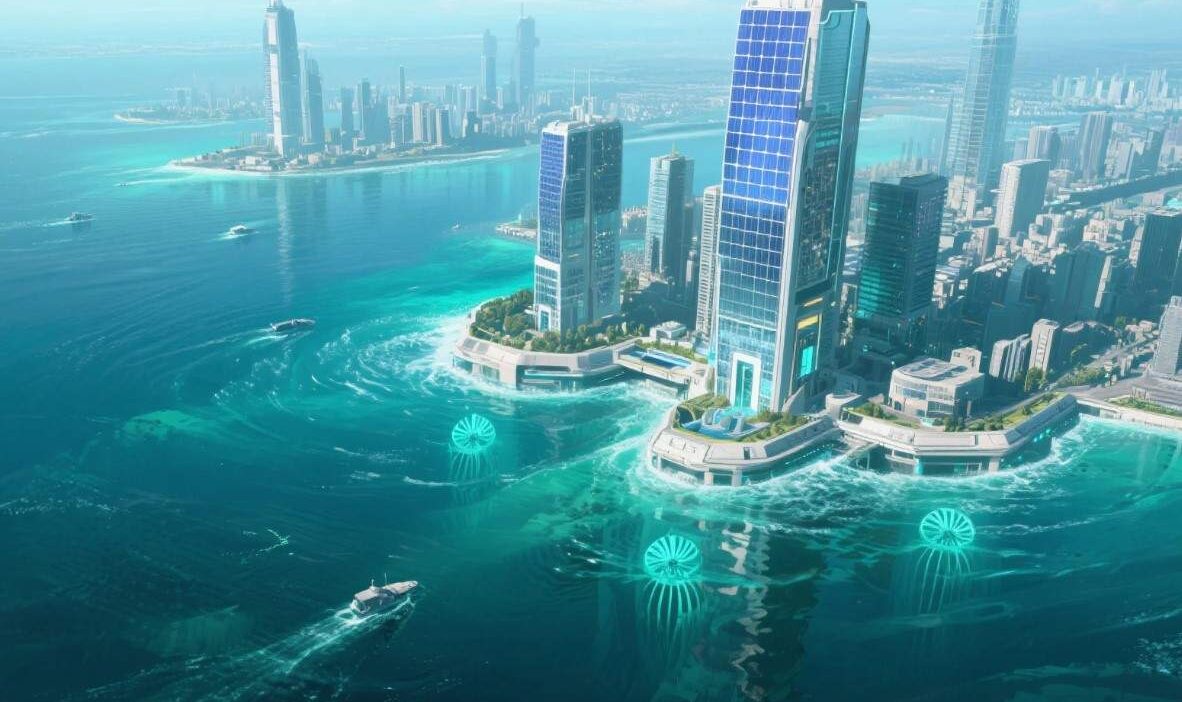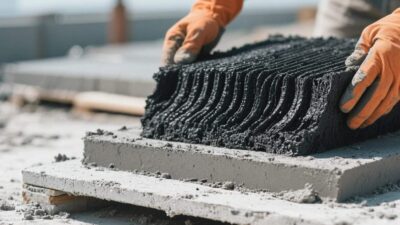Sailing Toward a Sustainable Future on the Waves
A City That Floats, Powered by the Ocean’s Pulse
Imagine a city bobbing gently on the ocean’s surface, its skyscrapers shimmering with solar panels, while underwater turbines hum with the rhythm of the tides. This isn’t a scene from a sci-fi novel—it’s the vision of floating cities powered by ocean currents, a revolutionary concept that merges human ingenuity with nature’s oldest energy source. As rising sea levels threaten coastal communities and the planet grapples with climate change, these floating metropolises offer a bold solution: cities that not only adapt to the ocean but harness its power to thrive sustainably.
Ocean currents, the silent rivers of the sea, carry enough energy to power millions of homes. By tapping into this renewable, predictable resource, floating cities could redefine urban living—reducing carbon footprints, enhancing resilience, and fostering innovation. Let’s dive into how this technology works, its potential, and the challenges that stand in its way.
The Science of Ocean Currents: Nature’s Reliable Energy Source
Ocean currents are driven by a combination of wind, temperature, salinity, and the Earth’s rotation. They form vast, interconnected systems—from the Gulf Stream warming Europe to the equatorial currents that drive global climate patterns. Crucially, these currents are constant and predictable, unlike solar or wind energy, which depend on weather conditions.
Why Ocean Currents?
- Energy Density: The kinetic energy of ocean currents is immense. For example, the Gulf Stream carries roughly 30 times more energy than all the world’s rivers combined.
- Low Variability: Unlike solar panels that idle at night or wind turbines that stall in calm weather, ocean currents flow 24/7, providing a steady energy supply.
- Carbon Neutrality: Harnessing ocean currents produces zero emissions, making it a strong candidate for decarbonizing urban energy grids.
Types of Ocean Currents for Energy
- Surface Currents: Driven by wind, these are shallow (up to 400 meters) and fast-moving (e.g., the Gulf Stream at 2–4 m/s).
- Deep Ocean Currents: Slower (0.1–0.5 m/s) but vast, these are driven by differences in water density (thermohaline circulation).
- Tidal Currents: Caused by the moon’s gravity, these are periodic but highly predictable, with peak speeds of 5–10 m/s in narrow channels.
The Tech Behind Floating Cities: Harnessing the Current
Building a city that floats and powers itself requires innovative engineering. Here’s how it works:
1. Underwater Turbines: Capturing Current Energy
The primary method of converting ocean currents to electricity is through underwater turbines. These devices, similar to wind turbines but adapted for water, have large blades that spin as currents pass through them.
- Design Innovations:
- Vertical-Axis Turbines: These rotate around a vertical axis, making them more efficient in turbulent currents.
- Modular Arrays: Turbines are grouped in underwater “farms” to maximize energy capture without disrupting marine ecosystems.
- Smart Materials: Blades made from lightweight, corrosion-resistant composites (e.g., carbon fiber) reduce maintenance costs.
In Norway, a prototype underwater turbine farm in the Sognefjord generates 1.5 MW of power—enough to supply 1,500 homes. Scaling this up, a single large current (like the Kuroshio in the Pacific) could power millions of floating city residents.
2. Floating Platforms: Stable, Adaptable Infrastructure
Floating cities need stable foundations that can withstand waves, currents, and saltwater corrosion. Engineers are experimenting with:
- Semi-Submersible Platforms: These rest partially underwater, using buoyancy to stay afloat while minimizing wave impact.
- Dynamic Positioning Systems: GPS and thrusters adjust the platform’s position to avoid strong currents or storms.
- Biomimetic Designs: Inspired by coral reefs or mangroves, these structures use porous materials to reduce drag and provide habitats for marine life.
Dubai’s Ocean Spiral concept envisions a floating city with a central tower connected to underwater habitats, powered by tidal and thermal energy. While still in design, it highlights the potential for integrating energy infrastructure with urban living.
3. Energy Storage and Distribution
Ocean currents provide steady power, but energy storage is critical for grid stability. Floating cities could use:
- Compressed Air Energy Storage (CAES): Excess energy compresses air in underwater caverns, released later to generate electricity.
- Flow Batteries: These store energy in liquid electrolytes, ideal for long-duration storage.
- Hydrogen Production: Excess current powers electrolysis, splitting seawater into hydrogen for fuel cells.
Benefits: Why Floating Cities Powered by Ocean Currents Matter
1. Climate Resilience
Floating cities rise with sea levels, avoiding the need for costly flood defenses. Their reliance on ocean currents reduces dependence on fossil fuels, cutting greenhouse gas emissions by 80–100% compared to traditional cities.
2. Sustainable Urbanization
By 2050, 68% of the global population will live in cities. Floating cities could alleviate overcrowding in coastal regions while providing affordable housing. Modular designs allow for easy expansion, adapting to population growth.
3. Economic Opportunities
Ocean current energy could create new industries—manufacturing turbines, maintaining floating platforms, and developing underwater tech. Coastal communities, often marginalized by climate change, could benefit from jobs and investment.
4. Marine Ecosystem Synergy
Floating cities, if designed sustainably, can enhance marine life. Underwater turbines act as artificial reefs, providing habitats for fish and coral. Solar panels on the surface could double as platforms for aquaculture, growing seaweed or shellfish.
Challenges: Navigating the Path to Reality
While promising, floating cities powered by ocean currents face significant hurdles:
1. Technical Complexity
- Durability: Saltwater corrosion, wave impacts, and extreme pressure (at depth) require materials that can last decades.
- Efficiency: Ocean currents are slower than wind, so turbines must be larger and more efficient to generate comparable power.
2. Environmental Concerns
- Ecosystem Disruption: Large turbine farms could block migration routes for marine life or alter current patterns, affecting fisheries.
- Noise Pollution: Underwater turbines generate low-frequency noise, which may disturb whales and other marine mammals.
3. Economic and Regulatory Barriers
- High Upfront Costs: Developing floating platforms and underwater turbines is expensive. Funding requires public-private partnerships and government subsidies.
- International Law: Ocean currents cross territorial boundaries, complicating ownership and regulation. Treaties like the UN Convention on the Law of the Sea (UNCLOS) must adapt to this new technology.
4. Social Acceptance
Residents may resist relocating to floating cities, fearing isolation or cultural displacement. Transparent communication and community involvement are critical to gaining support.
The Future: Sailing Toward a Blue Economy
The future of floating cities powered by ocean currents is bright, with innovations on the horizon:
- AI-Optimized Turbines: Machine learning models could predict current patterns, optimizing turbine angles to maximize energy capture.
- 3D-Printed Platforms: On-site 3D printing could reduce construction costs and allow customization for local conditions.
- Carbon-Negative Designs: Floating cities could integrate carbon capture systems, using seawater to absorb CO₂ and store it in underwater basalt formations.
Projects like the Blue City initiative in Singapore and the Ocean City concept by Dutch firm DeltaSync are already testing these ideas. As technology matures, floating cities could become a cornerstone of global climate strategy.
The Ocean’s Gift to Urban Innovation
Floating cities powered by ocean currents are more than a futuristic fantasy—they’re a pragmatic response to climate change. By harnessing the ocean’s endless energy, these cities offer a blueprint for sustainable, resilient urban living.
As oceanographer Sylvia Earle once said, “The ocean is the life support system of our planet.” By merging human ingenuity with nature’s power, we can build cities that not only survive but thrive—sailing toward a future where the ocean and humanity coexist in harmony.
Join the conversation at AIDNESS. Should nations invest in floating cities powered by ocean currents? Can we balance innovation with environmental protection? Share your thoughts—we’re all part of this journey to sail into a greener future.



